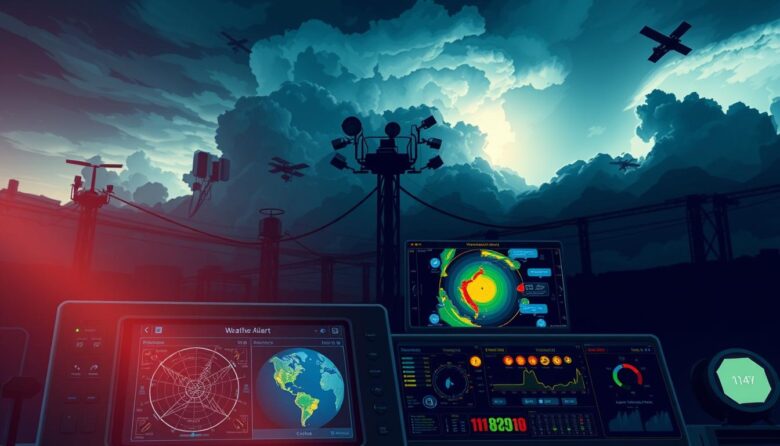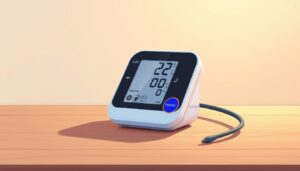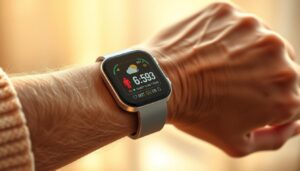Extreme conditions are growing more common across the U.S., turning blue skies into potential risks without warning. Your phone now acts as a personal safety companion, delivering instant updates that help you avoid dangerous situations. Gone are the days of relying solely on outdoor sirens or TV bulletins—today’s systems send life-saving notifications directly to your pocket.
Modern tools like Wireless Emergency Alerts use GPS and cellular networks to broadcast urgent messages nationwide. These automatic warnings don’t require downloads or subscriptions, ensuring everyone receives critical updates. For tailored protection, specialized services offer hyperlocal forecasts and storm-tracking features.
Understanding your options empowers smarter decisions. Real-time data lets you adjust plans before severe conditions arrive, whether you’re commuting or caring for family. Older adults particularly benefit from customizable setups that prioritize simplicity and reliability.
By embracing these innovations, you gain confidence to face sudden changes. Proactive planning reduces stress and keeps loved ones secure when unexpected events strike. Stay ahead of nature’s curve with technology designed to protect what matters most.
Understanding the Basics of Weather Alerts
When seconds count, clear communication becomes your strongest ally. Modern safety systems bridge the gap between authorities and communities, delivering urgent updates when threats arise.
What Are Wireless Emergency Alerts (WEA)?
These instant broadcasts connect you to government partners like FEMA and the National Weather Service. Unlike standard texts, they use dedicated channels to bypass network congestion. You’ll receive them automatically—no subscriptions or app installations required.
Messages focus on three primary categories: imminent dangers, missing persons cases, and national crises. Each transmission stays under 90 characters, prioritizing clarity over complexity. The concise format tells you exactly what’s happening, when to act, and who sent the information.
How Alerts Reach Your Device
Your phone’s built-in capabilities detect these signals through cellular networks and GPS. Distinctive audio tones and vibration patterns ensure you notice them immediately—even if your ringer’s off. This system operates independently from regular messaging services, maintaining functionality during peak usage times.
Trusted agencies tailor warnings to your location using real-time data. Whether you’re at home or traveling, updates reflect current risks in your area. This precision helps you make informed decisions without sifting through irrelevant details.
How Wireless Emergency Alerts Keep You Safe
Your phone becomes a lifeline when danger strikes. The system delivers urgent updates through streamlined formats designed for quick understanding. Let’s explore how these notifications work and why they’re essential for modern safety.
Message Formats and Alert Details
Every text message you receive follows strict guidelines to ensure clarity. Warnings about tsunamis, tornadoes, or blizzards include precise instructions like “Seek shelter now” or “Evacuate immediately.” These brief, action-oriented phrases eliminate confusion during high-stress moments.
Alerts automatically adjust based on your current location. If you drive into a storm’s path later, your device will ping with relevant updates. This dynamic tracking ensures you’re always aware of risks in your immediate area.
Recognizing Special Tones and Vibrations
A unique alarm sound plays for critical notifications—different from standard ringtones. Your phone might also vibrate in a distinct pattern to grab attention. These sensory cues help you recognize urgent messages instantly, even if your device is silenced.
Reliability During Emergencies
Cellular networks prioritize these alerts over regular traffic. During major disasters when calls drop, emergency updates still reach your screen. Broadcast towers send signals to every compatible device nearby without tracking personal data.
You’ll never pay extra for this service, and messages don’t consume data. Whether facing hurricanes or ice storms, this system remains your constant safety net. Pair these alerts with local news updates for complete situational awareness.
Weather alert apps seniors: Features, Benefits, and How to Choose
Technology simplifies safety by putting critical tools in your hands. The right applications blend accuracy with ease of use, helping you respond swiftly to changing conditions. Let’s explore what makes these tools indispensable for modern preparedness.
Trusted Data and Timely Updates
Reliable apps pull information directly from sources like NOAA and the National Weather Service. This ensures forecasts and warnings reflect the latest data, reducing false alarms. Rapid notifications give you extra minutes to act when storms intensify unexpectedly.
Look for services that update every 2-3 minutes during crises. Some even provide radar overlays showing precipitation patterns in real time. This level of detail helps you gauge risks accurately, whether facing thunderstorms or winter advisories.
Customization for Multiple Locations and Alert Types
Your favorite tools should let you monitor several places at once—like family homes or vacation spots. Adjust settings to receive only the types alerts that matter, such as flood warnings or extreme heat notices.
Clear visual layouts make navigation effortless, even during stressful moments. Bonus features like offline maps ensure access when networks fail. Pair these with social media sharing to keep loved ones informed instantly.
By prioritizing simplicity and precision, you’ll build a safety net that adapts to your lifestyle. Test different options during calm periods to find your perfect match.
Comparing Top Weather Alert Apps and Their Unique Offerings
Choosing the right tool for storm tracking requires understanding key differences between popular platforms. Each service shines in specific areas, from hyperlocal precision to crowd-sourced data collection. Let’s explore how leading options stack up against everyday needs.
Official Data Meets Customization
NOAA Weather Radar Live delivers unmatched authority by pulling directly from government sources. You get real-time satellite imagery and storm warnings verified by meteorologists. While its interface feels technical, the depth of information justifies the learning curve for serious users.
AccuWeather stands out with its MinuteCast feature, predicting rain start/stop times within 300 feet of your location. This helps you dodge downpours during errands or workouts. However, frequent ads might test your patience during critical moments.
Precision vs Community Power
Dark Sky’s hyperlocal approach once set the standard for minute-by-minute updates, though its future on Android remains unclear. Meanwhile, Weather Underground taps into 250,000+ personal stations for neighborhood-level accuracy. You’ll love the customizable maps if you enjoy diving into atmospheric details.
Consider interface preferences alongside data needs. Some platforms prioritize sleek design, while others offer scientific depth. Free trials help identify which balance of form and function works best for your routine.
Specialized Weather and Emergency Apps That Matter
Specialized tools transform your device into a powerful safety ally during critical moments. Whether tracking approaching storms or preparing for unexpected crises, these solutions fill gaps left by general platforms. Let’s explore standout options for specific scenarios.
Apps for Detailed Forecasts & Severe Weather
RadarScope gives you the same radar visuals meteorologists use, overlaying tornado warnings and hail markers. Outdoor enthusiasts love its real-time storm rotation data, though its technical interface might challenge casual users. For coastal activities, Windy excels with wave height predictions and side-by-side model comparisons to plan boat trips safely.
Storm chasers rely on apps like Storm for lightning strike maps and hail size indicators. These features help you gauge risks minute-by-minute during volatile conditions. Pair them with basic notification systems for layered protection against sudden changes.
Emergency Preparedness and Non-Weather Tools
The Red Cross Emergency app shines beyond forecasts by offering flood preparation checklists and shelter locators. Its offline mode keeps safety guides accessible during network outages, though weather updates become limited without Wi-Fi.
Consider combining specialized tools with broader services. A marine-focused app complements general forecasts if you frequent lakes or oceans. Always test features during calm periods to build familiarity before urgent situations arise.
Harnessing Technological Innovations for Aging in Place
Modern tools empower you to maintain independence while staying connected to what matters most. From managing daily tasks to nurturing relationships, today’s solutions blend practicality with peace of mind.
Using Tracking, Grocery Delivery, and Communication Tools
Your transportation needs transform with rideshare services like Uber or Lyft. These safe alternatives let you keep medical appointments or visit friends without relying on others. Pair them with delivery platforms like GrubHub to enjoy meals from favorite restaurants during storms or busy days.
Medication management becomes effortless with reminder systems that notify loved ones if doses are missed. Magnifying tools help read labels, while audiobook apps provide entertainment without straining your eyes. For those who cherish nostalgia, old-time radio programs bring back cherished memories.
Stay involved in family life by monitoring conditions in loved ones’ cities through forecast tools. Video chats and social platforms like Facebook let you share moments face-to-face, even across miles. Tracking features give relatives real-time updates about your location, balancing safety with privacy.
Explore genealogy through Ancestry.com or discover local events via AARP’s platform. These resources enrich your life while keeping you anchored to community and history. With thoughtful tech integration, every day feels both secure and fulfilling.
Tips to Optimize Your Weather Alert Experience
Staying prepared starts with smart customization of your notification tools. Tailor systems to match your daily routines and local risks while maintaining simplicity for stress-free use.
Setting Up Personalized Notifications
Adjust settings to receive alerts only for conditions impacting your area. Filter by flood risks or temperature extremes instead of getting every update. This prevents overload while keeping critical info accessible.
Test your setup during calm periods. Learn how different types alerts appear on your device—practice muting less urgent notices. Regular app updates improve accuracy and add features you might miss otherwise.
Compare multiple sources when severe conditions develop. One platform might detect storms faster, while another offers clearer radar maps. Knowing terms like “watch” versus “warning” helps prioritize actions without confusion.
Balance battery life with safety by limiting background updates for non-essential alerts. Sync preferred tools with family members’ devices to create a coordinated response plan. With thoughtful adjustments, you’ll stay informed without constant interruptions.



